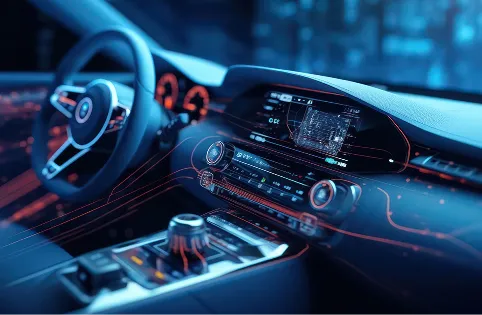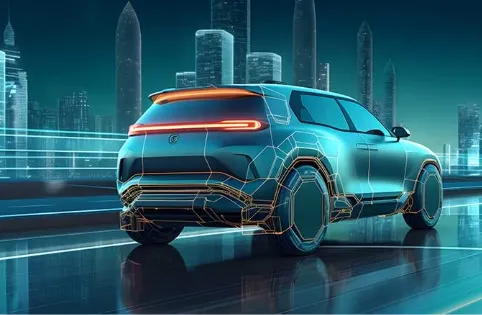What Is an Automotive Network?
An automotive network is the interconnected system of electronic components and devices within a vehicle that communicates and exchanges data to enable various functionalities, safety features, and operational capabilities. This network allows the integration of numerous systems, including engine control, safety features, entertainment, navigation, and more.
The automotive network comprises several other networks that facilitate communication among different components. The controller area network (CAN bus) is one of the primary networks in most vehicles, managing communication between control units such as the engine control module, transmission control module, antilock braking system, and airbag systems. It enables the exchange of data and commands between these units.

The automotive network forms the backbone of the vehicle’s electronic ecosystem.
Other networks, including the local interconnect network (LIN), FlexRay, and Ethernet, serve different purposes. The LIN often supports simpler, lower-speed communication, such as control of window motors or seat adjustments. FlexRay, on the other hand, is capable of higher data transmission rates and is commonly utilized in safety-critical systems such as electronic stability control. Ethernet is gaining prominence in vehicles due to its high data transfer rates. It supports applications such as infotainment systems, camera systems, and advanced driver assist systems (ADAS).
With the rise of electric and autonomous vehicles, the complexity of and demand for data communication within the automotive network have increased exponentially. This network’s robustness, reliability, and cybersecurity measures are crucial to ensure the safety and efficiency of smart, connected vehicles.
Components of an Automotive Network
An automotive network comprises a multitude of components, including:
- Electronic control units (ECUs): These embedded systems manage specific functions and mechanisms within the vehicle, such as the engine, transmission, braking, airbags, and more. Each ECU is responsible for specific tasks and communicates with other ECUs via the network.
- Sensors and actuators: Sensors collect data output regarding speed, temperature, camera visuals, and more. Actuators respond to this data by performing actions such as adjusting the engine timing, deploying airbags, or controlling the braking system.
- Communication buses: These are the communication pathways that allow the flow of data between ECUs, sensors, and other components. The CAN bus is one of the most common buses used for transmitting data between various systems in the vehicle.
- Gateways: These components manage the flow of information between different networks. The automotive gateway is a centralized hub of information transfer within the vehicle. It enables seamless interaction between various systems.
- Wiring harnesses: Physical wiring networks connect the different components, allowing the transmission of both power and data signals throughout the vehicle.
- Software and firmware: Essential for the vehicle’s function, these control the behavior of the ECUs, manage the data flow, and ensure the overall functioning of the various systems.
- Connectivity modules: Modern vehicles increasingly incorporate connectivity modules such as Wi-Fi, Bluetooth, and cellular connections. These enable over-the-air updates, remote diagnostics, connected infotainment systems, and other similar systems.
Collectively, these components form a sophisticated network within the vehicle, allowing the seamless operation of various functional systems, safety features, and entertainment systems, as well as the integration of advanced technologies such as autonomous driving and electric power trains.
» Learn More About the Automotive GatewayWhy Is an Automotive Network Critical to Vehicle Success?
Because reliability, security, and efficiency are crucial for vehicle safety and performance, the automotive network is critical. It supports:
- Safety and control: Components such as antilock braking systems, traction control, airbag deployment, collision detection, and more rely on the seamless communication and coordination facilitated by the network. This integration enables quick and coordinated responses to potential hazards on the road.
- Performance optimization: Engine management, transmission control, suspension adjustments, and other performance-related functions depend on efficient communication between various components.
- Efficiency and emissions: The automotive network allows the precise management and control of engine parameters, exhaust systems, and other components to meet environmental regulations and improve fuel economy.

The automotive network supports every aspect of performance, from safety to infotainment to updates throughout the vehicle’s lifetime.
- Integration of advanced features: Features such as ADAS, infotainment systems, connectivity, autonomous driving capabilities, and electric power trains rely heavily on a secure and efficient network.
- Future readiness and upgradability: Over-the-air updates and advancements in connectivity are transforming the automotive industry, and a strong network forms their foundation. Upgradability through software updates and the integration of new technologies is only possible with a robust network infrastructure.
Recent Advancements in the Automotive Network
Advancements in automotive networking are revolutionizing the industry. The field is continuously evolving, and some of the most significant recent advances include:
- Ethernet in vehicles: Ethernet, known for its high data transfer rates and reliability, is being integrated into vehicles to support increasing data demands for ADAS, infotainment, and other high-bandwidth applications.
- Secure communication protocols: Manufacturers are working to implement robust security measures to protect automotive networks from cyberthreats and unauthorized access.
- Over-the-air (OTA) updates: Automotive manufacturers are increasingly offering OTA software updates for vehicles. This advancement improves functionality, performance, and security without requiring a visit to a service center.
- Integration of 5G technology: 5G promises faster and more reliable connectivity, enhancing vehicle-to-vehicle (V2V) and vehicle-to-infrastructure (V2I) communication and supporting autonomous driving functionalities.
- Time-Sensitive Networking (TSN): This evolving Ethernet standard provides real-time communication with determinism, necessary for safety-critical applications such as autonomous driving.
- Artificial intelligence (AI) and machine learning (ML) integration: These technologies, which analyze vast amounts of data from various sensors and systems, are used for predictive maintenance, optimized vehicle performance, and enhanced safety.
How Can Wind River Help?
Wind River Edge
Automotive development is shifting from hundreds of loosely connected single-function ECUs to complex, integrated software on a few highly connected, high-performance domain and zone controllers (HPCs). VxWorks®, Wind River® Linux, and Wind River Helix™ Virtualization Platform all facilitate this transition.
VxWorks
VxWorks provides support for OCI-compliant containers to enable software modularization, microservices, and ease of over-the-air updates at lower cost. Industry-proven solutions can be used to deploy software reliably at cloud scale.
Wind River Linux
As the embedded industry’s most advanced Linux platform, Wind River Linux helps teams develop, deploy, and operate robust, reliable, and secure embedded solutions running on a purpose-built Linux operating system.
Helix Platform
Helix Platform delivers a safety-certifiable multi-core virtualization platform that supports mixed-criticality systems, so automakers can safely deploy ADAS applications on the VxWorks RTOS while running infotainment applications on Wind River Linux, Android, or other operating systems. And they can run all these applications on the same hardware without compromising performance, safety, or security.
» Learn More About VxWorks» Learn More About Wind River Linux
» Learn More About Helix Platform
Wind River Studio
Wind River Studio provides an end-to-end software platform that enables its users to develop in the cloud, deploy over the air, and run and manage software at the vehicle edge.
- Wind River Studio Virtual Lab and Wind River Studio Test Automation: Faster time-to-market requires automated development workflows, and safety, simulation, and testing must all be thorough as well. Studio Virtual Lab and Studio Test Automation connect hardware to the cloud and automate all levels of testing, from unit tests to system tests that include hardware.
- Wind River Studio Digital Feedback Loop and Wind River Studio Over-the-Air Updates: Studio Digital Feedback Loop enables real-time analytics and insights from OS-level and application-specific telemetry and edge device data. Automakers can incorporate these insights into the development flow, create updates and fixes quickly, and download to the vehicle via Studio Over-the-Air Updates.
- Wind River Studio Gallery: Modularization and extensibility are key to the DevOps environment, and you can bring your custom development tools into the Studio environment via Studio Gallery, an ecosystem of third-party and custom tools and software that extends Studio capabilities and helps integrate Studio into existing workflows.

Wind River Edge and Wind River Studio provide the tools to create robust automotive networks for the evolving automotive industry.
Wind River Safety and Certifications
Wind River has decades of experience in safety and certification at the highest criticality levels and in the toughest environments, including ISO 26262 ASIL-D certifications. Additionally, our development processes and tools are highly secure, with role-based access control (RBAC), two-factor authentication, and more.
» Learn More About Wind River Safety and Certification
